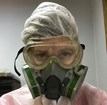National Center for Preservation Technology and Training (NCPTT) publishes its Preservation in Practice Series to provide easily accessible guidelines for preserving cultural materials. NCPTT is the principal research, technology and training center within the National Park Service.
-
Article 1: Preservation Matters: Disasters - Saving Wet Photographs

When a disaster strikes the cleanup and recovery can be overwhelming leading to the disposal of cherished possessions. Preservation professionals commonly see homeowners throwing away items that can be recovered and saved after a flood. This document outlines steps that individuals can take to assess and salvage valuable family photographs after a devastating flood or storm. Read more
-
Article 2: Preservation Matters: Disasters - Saving Wet Textiles After a Flood

When dealing with flood damaged textiles, recognize that different materials will react differently when wet. Wet textiles may be more fragile or shrink or distort as they dry. Dyes can transfer from one fabric to another. In this document, preservation professionals offer general advice on how to salvage textiles after a flood event. Read more
-
Article 3: Preservation Matters: Disasters - Cultural Resources and Covid-19

This document explores how COVID-19 persists on surfaces and how you can effectively deactivate the virus while preserving valuable cultural resources. Read more
-
Article 4: Preservation Matters: Landscape Maintenance - Replacing Historic Plants with Alternative Types

Vegetation in historic landscapes includes individual plants, such as a specimen tree or shrub, or groups of plants that form an orchard, hedge, shrub bed, or a woodlot. In different landscapes, vegetation may include woody plants such as evergreen or deciduous trees, shrubs, and ground covers, and herbaceous plants such as ferns, annuals, perennials, and herbs. Read more
-
Article 5: Preservation Matters: Remote Sensing - Metal Detecting

Metal detecting is a widely used survey technique in archeology since the late-1950s on sites where metals are present. Metal detectors are relatively inexpensive and effective remote sensing devices that should be part of the tool kit of archeologists working at sites where metal artifacts are likely to be a part of the site assemblage. Read more
-
Article 6: Preservation Matters: Disasters - Saving Wet Books After A Flood

Wet books and papers are some of the most fragile items to be salvaged from a home or library after a flood. Paper loses strength when it gets wet, and books suffer damage due to swelling. Additionally, mold may begin to grow when objects are left damp for approximately 72 hours. You want to be prepared once you get back into your home or library. This document is a quick reference; more in-depth instructions can be found at the websites listed at the end. Read more
-
Article 7: Preservation Matters: Maintenance - Graffiti Removal from Historic Features

The presence of graffiti on building materials is ubiquitous in urban and rural environments. Graffiti can affect many types of building materials and can cause properties to be devalued. Community law enforcement officials recommend rapid removal of graffiti to discourage vandals from adding more graffiti. Methods of graffiti removal should be cost-effective and easy to use, and result in minimal changes to the surface of historic structures. Read more
-
Article 8: Preservation Matters: Landscape Maintenance - Protecting Historic Trees During Construction

Historic trees are valued as living witnesses to earlier times, events, and stories at historic properties. They are often cherished and appreciated for their stature in the landscape and how their majestic qualities contribute to conveying the history of a site. Such old trees, however, are vulnerable to impacts from site use and construction, such as soil compaction and physical damage to roots, trunk, and limbs. Read more
-
Article 9: Preservation Matters: Landscape Maintenance - Rejuvenating Historic Deciduous Shrubs

Shrubs can be important features of cultural landscapes when they are associated with, and contribute to, conveying the significance and character of a historic property. Shrubs often stay alive in a landscape for decades, sometimes centuries. However, if shrubs are not carefully maintained, with age they can lose vigor, deteriorate, and die. Pruning of older shrubs can effectively rejuvenate and preserve them as contributing features of a cultural landscape. Read more
-
Article 10: Preservation Matters: Remote Sensing - Ground Penetrating Radar

Ground-penetrating radar (GPR) is perhaps the most recog- nizable geophysical survey technique used in archeology. The radar signal, an electromagnetic pulse, is directed into the ground. Subsurface objects and sediment layers with contrasts in physical and chemical properties will cause reflections that are sent back to a receiver. The two-way travel time and the assumed speed of the energy of the reflected signal(s) are used to calculate the depth of targets and layers. Read more
-
Article 11: Preservation Matters: Disasters - Mold on Cultural Resources and Collections

Mold is a type of fungus, with more than 250,000 types identified and many more yet to be classified. Mold feeds on nutritious organic materials and is integrated into the ecosystem; its primary purpose is to decompose organic materials, recycling them back into the environment. Read more
